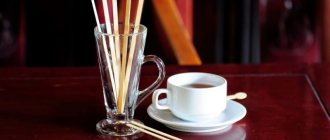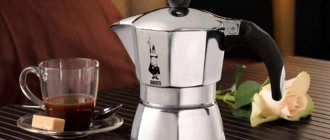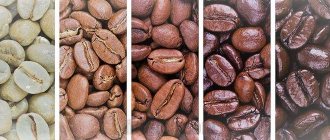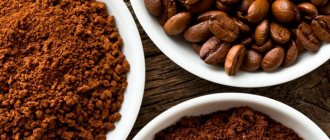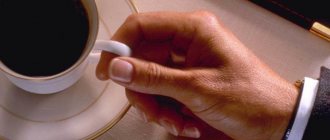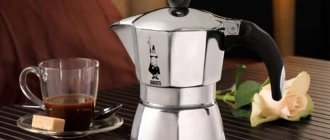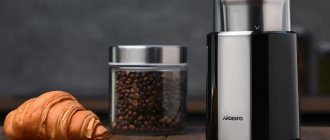The answer to the question of how to properly hold a coffee stick usually doesn’t bother people. Who cares how you stir your drink if you are late for work and want to drink it as quickly as possible. But connoisseurs of the drink attach great importance to this. The topic of using spoons is a source of heated controversy. To get the hang of things, learn about special accessories and their types. We will teach you how to stir coffee correctly.
How to hold coffee sticks correctly
Coffee gourmets are sure that everything in coffee is important down to the smallest detail. Many may find the argument that the coffee stick should be held correctly to be stupid.
Where coffee is served with a stick
You can find the accessory in any coffee machine, in small cafes and other places. Instead of the usual spoons, the drink is served with sticks. After their appearance, establishment owners reduced costs and increased the quality of service.
You won’t see chopsticks in expensive establishments; they won’t look out of place there. In restaurants, coffee is usually served in beautiful dishes with a coffee spoon.
What does this coffee accessory look like?
The main purpose of the stick is to stir drink additives, such as milk or granulated sugar, into a cup until smooth.
The advantages of such sticks are as follows:
Stirring the drink in small containers with a stick is much easier than with a teaspoon. They come in different sizes; for example, for some types of coffee, elongated sticks are used.
How to hold it correctly
The question caused heated discussions among Internet users. It became clear that for an accurate answer you need to take into account everything, down to the smallest detail. One of the important points is the type of accessory and its difference from other types.
Classification by material:
According to their purpose, stirrers are divided into:
Using regular chopsticks is quite easy. They hold it by the long handle and mix the coffee drink with the wide side. Manufacturers make holes at the bottom of the stick so that during mixing, liquid passes through them, and the drink is stirred more thoroughly.
The right to such an invention and the method of its use was patented by a Russian entrepreneur in 1999. The document states that the stirring stick consists of two parts - a holder and a working part. The handle is considered to be the narrow end. Working - expanded with holes. The holes reduce liquid resistance, and the sugar is stirred several times faster. The shape of the stick is ideal for holding in your hands.
There are many conflicting opinions about how to hold a wand correctly. The controversy surrounds chopsticks made of plastic. There are usually no problems with wooden accessories, since they have equal proportions on both sides. This question especially worries people who try to do everything in accordance with the rules of etiquette.
European traditions
In many European countries, people use the tapered side to stir coffee. In Russia, people do the opposite. Why is this happening? Actually the explanation is simple. In Europe, sticks are placed in the machine so that they come out with the wide part forward for buyers. Holding the spatula, people begin stirring the coffee with the narrow side. In Russia they do the opposite, as they draw an analogy between a chopstick and a homemade coffee spoon. In this regard, stir the drink as you are used to doing it at home.
It will not be possible to find a definite answer to the question of correct holding until general rules of use are introduced.
Advice from experienced coffee lovers on choosing the right stick
Many people, before buying this accessory, wonder how best to choose them. Barista Tips:
Baristas unanimously say that which side you hold the stick for stirring coffee is not at all important. You need to do it the way that seems most convenient. The main thing is not to touch the part that will be immersed in the liquid with your fingers. For those people who are concerned about the issue, experienced coffee lovers give good advice - to use wooden sticks with ends of the same size.
Source
From revision to release - the final stages of work
Once the main meshes are uploaded and configured, the design phase begins. The scene is filled with detail objects (props), the terrain with adjacent geometry is tinted, test lighting is adjusted and baked, and so on. In addition, at this stage we draw RGBA masks for buildings, simulating light wear and tear of a natural nature: streaks, dirt, dust, soot, rust, etc. They are needed to break up monotonous tiles on large surfaces, emphasize volume, and generally add a certain amount of artistry and liveliness to the picture.
This is what the map looks like before baking the light and filling it with detail objects:
And this is after final polishing:
And again, the main thing here is not to oversaturate the scene with small objects, which will subsequently have to be removed when generating different qualities (HD, LD, ULD). We also monitor the composition of objects in the frame so that it looks beautiful and harmonious from any angle of the game camera. If necessary, we reduce the textures by tone and color so that they do not stand out from the overall picture.
Next comes optimization - one of the first technical stages, after which the card gets into the build. Here the LODs, materials, drawing distance are adjusted, and if critical bugs are found, the geometry is corrected. After adding all objects to the source scene, it is transferred to the level designer to review the geometry and readability of the environment from a gameplay point of view. After this, it is considered that the level is completely ready, and the next stage of generating different qualities (HD, LD, ULD) from the original source scene begins. Technical artists have excellent tools in their arsenal to automate this process, but manual revision is still inevitable.
This is what HD, LD and ULD card presets look like:
After generating a map in different quality presets, it is given back to level designers. They again test the now updated geometry, level readability and provide general feedback. In addition, at the final stage of creating a map, level designers send it for external testing several times. This is a separate test server where we invite players to evaluate new content that is being prepared for release. This method allows us to collect feedback on gameplay aspects, graphics, and also evaluate the performance of the card, so to speak, in “combat” conditions. We will talk about this in more detail in the next article.
After all the edits and modifications, the QA department takes over the map. Testers carefully check the level for various bugs related to graphics and gameplay. Testing is performed on all kinds of smartphones and tablets to make sure that the card will look good on the device, regardless of its technical content. Here the final check of the scene performance and comparison of its performance with other cards takes place.
And finally, the card goes into play. After this, artists and modelers can begin reworking the next map. In the meantime, level designers and the technical team of the project monitor the performance of the one that went into release, technical support specialists collect complaints from players related to potential bugs at the level, and community managers monitor reviews on social networks. This process of supporting the map after release is no less important than the rest: here we catch unnoticed bugs and other issues, which we finalize for the next planned release. Thus, working on the map becomes a continuous process that does not end even when the level is ready for release. Which, however, is considered normal for any GaaS.
Before/after: map from “vanilla” War Robots and War Robots Remastered:
How to hold a coffee stick correctly
There are no trifles in the coffee business. Even the most inconspicuous, at first glance, accessory can give rise to many disputes about the correctness of its use. For example, do you know how to hold a coffee stick correctly? Do you think these are insignificant details? Well, as they say, the main thing is in the details. Let's find out what types of sticks exist and how to handle them?
About the reasons for the emergence of tradition
Let us explain for those who are “hooked”. The fact is that abroad, sticks are filled into coffee machines so that they are served to customers with a “spatula” forward. That’s why coffee consumers grab the “spatula” with their fingers, stirring the drink. Accordingly, the other part of the device is specifically the stirring itself. Russian consumers are guided by a slightly different logic. They use the wide end of a coffee stick (similar to a tea or coffee spoon) to stir sugar in a drink.
There is no absolutely correct answer to the question of how to properly hold a stick for stirring coffee. It cannot exist, at least until such time as the nuances of a good tone regarding the consumption of an invigorating drink in fast foods and coffee machines are invented.
What is a coffee stick?
Speaking in the dry language of terms and definitions, a coffee stick is a disposable accessory for stirring sugar, milk and other additives to obtain a smooth drink.
Sticks are dispensed by coffee machines; they are an indispensable attribute of fast food chains; they can also be found at the counter in a signature coffee shop.
What are the advantages of such accessories?
For large cups in which cappuccino or latte are served, there are sticks of a special format; they are longer than usual.
What types of coffee stirrers are there?
In coffee accessories stores, coffee sticks are divided into several types
According to the material of manufacture
Plastic coffee sticks . They look like a miniature oar - a long, rather thin handle ends in an expanding blade with holes. These “windows” are designed to quickly and evenly mix the sugar. The shape of the blades can be different. There are options with widened or narrowed blades, with three or two holes.
Plastic coffee sticks are dispensed from coffee machines and are popular in fast food establishments and mobile coffee shops.
Wooden coffee sticks . Most often, bamboo is used as a manufacturing material. Wooden coffee stirrers are most reminiscent of the once popular ice cream sticks that were offered in every store in the Soviet Union. Wooden coffee sticks are of equal width along the entire length, with rounded ends on both sides.
Bamboo coffee stirrers can be seen more often in small coffee shops, on bar counters and even in restaurants.
By size and purpose
Extended stirrers with a length of 160-180 mm are made only from wood.
Types of devices
The types of cutlery for stirring depend on the situation and the specific drinks with which they are served. They can be metal, plastic, wood. They have different sizes. Decorative spoons also have their own characteristics related to their shape. Let's get acquainted with the most common ones.
- Plastic spoons have a long thin handle with a wide end and a small hole. Coffee stir sticks are dispensed from machines installed by fast food chains. Size - 10-12 cm.
- Wooden utensils are made from bamboo. There are no holes on them. They have the same width along the entire length, and the ends are rounded. They are often served in small restaurants and cafes. The average length is 18 cm.
- Decorative disposable spoons are made of plastic. Their main difference is the variety of unusual shapes. There are spoons in the shape of hearts, fruits, and bats. Plastic spatulas are used during the holiday.
Interesting! Can coffee make you fat?
How to hold a stirrer correctly
It would seem that the question is simple, but there are two opposing positions on it. If everything is clear with wooden coffee sticks, because they have absolutely the same shape at both ends, then with plastic stirrers it’s not so clear.
The main question is whether the spatula should actually serve as a stirrer or, nevertheless, act as a finger holder.
In Europe, coffee is stirred with the narrow end of a stick. We use the opposite approach, when we stir the drink with a spatula with holes.
Why did such traditions develop?
What is the best way to use coffee sticks?
There is simply no clear answer to this question. Perhaps because it does not occur to anyone to regulate or elevate the process of drinking drinks from vending machines or in fast foods to the rules of good manners.
Faster, bigger, more powerful: changes in the technical pipeline
For a remaster, it’s not enough to create a beautiful picture; it’s equally important not to lose performance compared to Legacy cards. This became possible thanks to the work of our graphic programmers and technical artists, who provided us with modern, standard-compliant tools for creating environments.
In terms of code, we have rewritten almost the entire rendering pipeline (Scriptable Render Pipeline, SRP), and now instead of classic material rendering (diffuse/normal/specular), we use modern physically correct rendering - PBR (albedo/metallic/normal/smoothness) for more accurate transfer of physical properties of materials. But we will talk about this in more detail in future articles.
In addition, we began to use a modern approach of tiles and trims instead of a large atlas of textures for the entire location, which allowed us to simplify the texturing of a large array of similar objects, as well as save memory on mobile devices.
What are tiles and trims?
- Tile texture (Tile sheet) is a uniform texture that can be repeated n number of times both horizontally and vertically without any visible seams;
- Trim sheet - the same tile, but repeated in one direction: either horizontally or vertically.
The main restrictions on textures imposed by the memory of low-end devices are one, maximum two arrays of 16 textures with the same resolution of 512x512px for the main geometry of the level, which can and should be textured with tiles and trims. For an HD preset, we can use a resolution of 1024x1024px with more progressive compression algorithms - and this hardly increases memory consumption, but in fact the visual difference on the screens of mobile devices is small. Usually we use one texture array for the level geometry and for the terrain, each using its own shaders for specific tasks. For example, industrial objects do not need such a smooth transition between textures as on terrain. In general, any smooth blends are more difficult to calculate for the GPU, so we use the terrain shader only on natural objects.
Atlas for the Canyon Legacy map (2048×2048px)
Set of 16 textures for the Canyon Remastered map (512×512px)
As for polygons, here we have also stepped far forward: now for an HD quality preset we have up to 500 thousand triangles at our disposal, whereas previously there was a maximum of 200-300 thousand.
How to choose coffee sticks
If you decide to get your own set of coffee sticks, then the advice of an experienced barista will help you make the right choice.
In Europe, even very expensive establishments can offer disposable sticks for stirring coffee, since for them the most important issue is not aesthetics, but hygienic and medical safety.
How to stir coffee with chopsticks is not particularly important; it is a matter of tradition, or, more correctly, habit. The main requirement is not to intercept the opposite end of the stirrer with your fingers. If you take the narrow side, interfere with the wide side. Did it happen the other way around? It's okay, this is also completely acceptable. If you have a choice about which stick to use, stick to wooden stirrers. It is simply impossible to hold them incorrectly.
How do you hold such a stick?
Source
Where can I find this device?
In fast foods, coffee vending machines and roadside cafes, the usual coffee (tea) spoon has long been replaced by a coffee stick, thanks to which the owners of catering establishments are able to significantly reduce production costs and at the same time improve the quality of service.
Naturally, this does not apply to restaurants and expensive cafes. In such places, introducing a coffee or tea stirrer will look somewhat inappropriate. In respectable establishments, the only and irreplaceable companion to a nice cup of fragrant drink, usually served on a beautiful platter, is usually a coffee (tea) spoon.
It is clear that in some European countries even expensive restaurants can serve coffee with a single stick. It would seem that the corporate style is being violated, and yet the restaurateurs can be fully understood: the first place for them is not aesthetics, but the health of the guests, which almost entirely depends on the hygiene of the accessories they use.
How to hold a coffee stick - debunking the legend
You may have already been puzzled by the statement that to hold a coffee stirring stick by the wide side. It’s quite possible to fall into a slight stupor - after all, it’s much more convenient and rational to hold it, since everyone is used to holding it in a narrow part.
Just a small spoiler for those who are in a hurry - it is correct to hold the coffee stick by the narrow side, and stir with the wide side. You can read why this is so below ⇓
This is a screenshot of the patent:
As you can see, it indicates that the coffee stick is different:
– making the working part in the shape of a spatula with a semicircular upper side; – making windows on the surface of the working part of a rectangular shape with rounded corners and a semicircular side; – radius coupling of the sides of the working part and the handle at an obtuse angle; – making a rectangular handle with a slight bevel to the base of the working part.
So everything is as simple as possible - correctly stir the coffee with a stick, holding the narrow side , and stir with the wide side. At least that's what its designer intended, the holes in the stir seem to create additional swirls of water (or so I think), which helps the sugar dissolve quickly.
I would like to note that there is a statement circulating online that in some EU countries it is customary to hold coffee stirring sticks by the reverse side. They say that the first time the sticks were loaded incorrectly into coffee machines, which led to this misconception.
Source
Coffee stick: how to hold and stir coffee correctly
Coffee shops often provide a stirrer with the drink to mix the drink. One side of it is long and narrow, and the other ends with an extended spatula with holes. But many people don’t know how to hold a coffee stick correctly. Everyone justifies their version, finding compelling arguments, depending on ease of use.
For many people, it doesn't matter which side of the chopstick you use to stir your coffee. But real coffee lovers try to follow the rules of etiquette - the entire coffee drinking ceremony must take place according to established canons, and which side the spoon is held on is of great importance.
Advantages
Users unanimously note the advantages of this device, which is different:
- Hygienic. Unlike ordinary coffee spoons, these sticks are disposable, because, as scientists convince, they do not pose any health risk.
- Ease of use. This device can be used no matter what type of coffee cup you use.
Unlike teaspoons, a coffee stick is convenient for stirring drinks in tiny cups. There are special sticks for stirring cappuccino and lattes, longer than regular ones.
Who invented the accessory
You can learn how to hold a coffee stick correctly by reading the history of its appearance. The product was patented in 1999 by Russian entrepreneur Elena Baturina. The patent contains a description of the coffee stirrer and the essence of its use. It indicates that the accessory has a working part in the form of a wide spatula with rectangular windows. The holes are designed to reduce liquid resistance when stirring the drink in order to quickly dissolve the sugar. It is said about a rectangular handle, which is located under the bevel to the base of the working surface.
Now, if you have a coffee stick in your hands, you know how to use it correctly, and you will not find yourself in an awkward position when you find yourself in a cultural society. And using a coffee stirrer, holding it by the long side, is much more convenient.
Source
How to use it correctly
Most of our compatriots do not see any difference in how to use disposable spoons. But simple logic dictates that to stir sugar, you should take the spoon by the handle and stir the drink with the wide part.
If you stir the sugar with a narrow handle, it will take longer to dissolve.
But in some places in Europe such spoons are used differently. They are taken by the wide end and the drink is stirred with the narrow side. There is a legend that they started using the wand this way after unsuccessfully refilling coffee machines. Spoons were served wide side forward. The Europeans, naturally, got used to it, and when they noticed the mistake, everyone continued to drink as they had before.
Choosing the right product
In stores, coffee stirrers are usually sold in batches of 250 pieces. The average price of one stirrer in Moscow is 50 kopecks. For coffee machines, choose devices with a length of 100-115 mm. Wooden products measuring 120 mm are suitable for take-away glasses. If the portion of drink is large, then it is better to purchase models larger than 16 cm. It is advisable that each one be individually packaged.
Now you know how to properly hold a coffee stirrer. If you liked the article, leave your review in the comments and share the article with your friends.
Source
Barista tips for choosing coffee tools
It’s not just the question of how to hold coffee sticks correctly that worries lovers of this fragrant drink. Many of those who would like to purchase this device do not know how to choose it correctly. For those who set out to purchase their own set of coffee sticks (namely for business), it would not be superfluous to listen to the advice of the most experienced baristas:
- It is better to get sticks in wholesale stores. Usually 250 sticks are much cheaper per unit.
- If devices are purchased for a machine, it is recommended to choose sticks with a length of 100-120 mm.
- The problem of color choice is also important. The best thing, according to scientists, is to purchase a set of brown or snow-white sticks. Some coffee lovers say that transparent coffee devices are less comfortable to use. In fast foods, they are combined with the general background of the dishes.
- Baristas consider wood sticks to be an ideal option.
- For large drinks (lattes, etc.), devices with a length of 120-160 mm should be used.
- Scientists advise receiving devices for stirring coffee in personalized packaging, providing each stick with its own “pencil case” made of paper. This machine increases the hygienic safety of the device.
The question of how to hold coffee sticks correctly is not considered a matter of principle by professional baristas. It is recommended to do what is more familiar and convenient for you. Just don’t grab the other end of the device with your fingers. But if the question is still fundamental, it is better to choose wood coffee sticks.
How to properly stir coffee with a plastic stick.
In the mystery of making and drinking coffee, every detail is important, and even such an insignificant element, like a disposable spoon, can give rise to disagreements. Many articles have appeared on how to properly stir coffee with a plastic stick. Some creators say that the wide part is recommended to be used as a handle, and not for stirring sugar, as we are used to.
